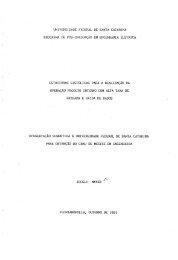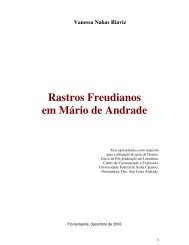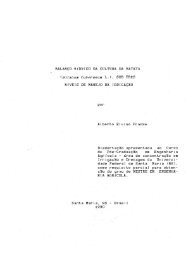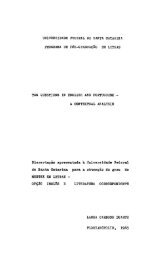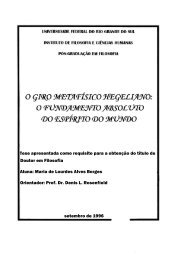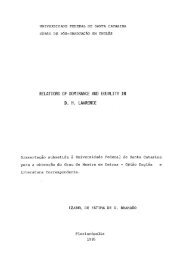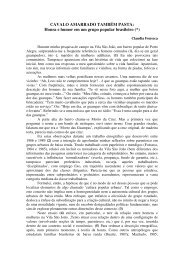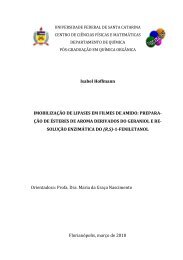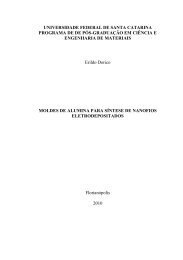(Idéias julho/07) - Universidade Federal de Santa Catarina
(Idéias julho/07) - Universidade Federal de Santa Catarina
(Idéias julho/07) - Universidade Federal de Santa Catarina
You also want an ePaper? Increase the reach of your titles
YUMPU automatically turns print PDFs into web optimized ePapers that Google loves.
ABSTRACT<br />
The subject environmental risks, and, between them the social unequalities and<br />
natural catastrophes, it has been a world-wi<strong>de</strong> preoccupation. In Brazil several<br />
inquiries are turned to urbane problems resulting from the occupation of spaces<br />
without the proper consi<strong>de</strong>ration social environment. And, in the relation with the<br />
economical system the structure and the environmental quality are characterized like<br />
poverty of and in the urbane one. The municipality of Marechal Cândido Rondon,<br />
situated in the West of the Parana, was colonized, effectively, from 1950, and since<br />
the 1980s the urban population exceeds the rural and today it represents over 90 %<br />
of the total. The city is located on the divisor of waters. In the study on the city of<br />
Marechal Cândido Rondon they are to the questions ma<strong>de</strong> a list to the occupation of<br />
areas unsuitable for the population concentrated, I eat them of voçorocas and in<br />
slope, related to events of concentrated rains, which started to be occupied from that<br />
time. Allied to these questions there has been also the great quantity of black pits<br />
(approximately 14.000 unities) or sinks of domestic drain, which function is to absorb<br />
and to purify the same thing and to contribute with the refuelling of the un<strong>de</strong>rground<br />
sheets. The physical aspects and the forms of occupation of the ground turn in<br />
vulnerable areas and of environmental risks. The areas of bigger risk of flooding and<br />
of collapse reach the urbane resi<strong>de</strong>nts of a general form, since they all have pits and<br />
the allotments and occupations of areas of gullies do not <strong>de</strong>pend on the purchaising<br />
power. The concentrated rains and his dislocation cause flooding, lixiviations and<br />
erosive processes, also in subsurface, producing sinking of built areas placing in<br />
risks his occupants. The resi<strong>de</strong>nts realize the risk of flooding, sinking and of collapse,<br />
recognize the damages and factors that stipulate them, however, <strong>de</strong>ny or coexist with<br />
the risk. Getting the own house, the attachment to the place and the social relations<br />
(families, neighbors and friends) they have a ten<strong>de</strong>ncy to be more important. The<br />
analysis and the knowledge of the dynamic one of the scenery, principally, of the<br />
pluvial waters, when too many urbane characteristics were ma<strong>de</strong> a list to, should<br />
prece<strong>de</strong> new areas of allotment and the construction of sinks. However, it was noted<br />
which actions in or<strong>de</strong>r that new environmental acci<strong>de</strong>nts were avoi<strong>de</strong>d are restricted<br />
to individual measures, like the filling out or revetment of pits, to do more reinforced<br />
walls, to stand up I halve it of the si<strong>de</strong>walk, to sell the house. Meanwhile, allotments<br />
at unsuitable places keep on being approved, for the public power, and, standards<br />
and inspections for the construction of sinks are not carried out, in spite of predicted<br />
in the master plans.<br />
Words keys: risks, gullies, black pits, flooding



